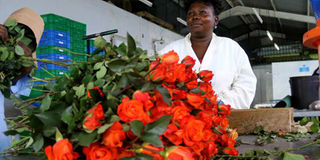China tax hits flower sellers

An employee grades cut flowers at the De Ruiter East Africa showhouse in Naivasha. Flower growers are scouting for new market destinations to diversify their markets away from the traditional European markets. FILE PHOTO | NATION MEDIA GROUP
What you need to know:
- Besides China, the flower growers were eying Japan, North and South America, Australia and other Asian markets.
- Ngige challenged flower breeders to come up with new varieties and colours to attract the emerging markets and young people in the new destinations.
- The association promotes cut flowers in other countries on behalf of farmers besides supporting delegations to attending international expos.
Flower growers are scouting for new market destinations to diversify their markets away from the traditional European countries.
The flower growers during the 2017 IFTEX exhibition in Nairobi this week said they were courting emerging markets such as China.
However, they noted the duty charged on goods exported to China has made accessing the country extremely difficult.
Richard Fox, Kenya Flower Council chairman, said that even though the EU market remains an important destination, China offers another good market but the many restrictions hinder trade.
“We would like a duty free export to China because currently there is 4 per cent duty, which one needs to pay when exporting produce. The issue must be addressed to facilitate market access,” said Fox.
Besides China, the flower growers were eying Japan, North and South America, Australia and other Asian markets.
Jane Ngige, Kenya Flower Council chief executive officer, asked the government to address the market access to China to ensure trade balance between the two countries.
Imports from China hit Sh320 billion last year while Kenya’s export to the Asian nation stood at less than Sh3 billion.
“We are aware that the Chinese produce their own flowers but we also know they love those from Kenya. We therefore need duty-free and quota-free trade to enable us access their market without any difficulties,” said Ngige.
The flower growers, on the other hand, do not pay tariffs to export produce to Japan, she said.
LEADING FLOWER GROWER AND EXPORTER
Ngige challenged flower breeders to come up with new varieties and colours to attract the emerging markets and young people in the new destinations
Other than trade dynamics, Kenya continues to face stiff competition from the neighbouring Ethiopia whose flower industry has been experiencing remarkable growth over the last 10 years.
Tewodros Zewdie, executive director Ethiopian Horticulture Producer Exporter Association, attributed their growth to conducive agri-ecology of their country as well as supportive government policies.
The association promotes cut flowers in other countries on behalf of farmers besides supporting delegations to attending international expos.
“Some of the policies which have ensured our growth include moderate land lease rates, no levies on capital goods for export, and loss carry forward for up to three years in case a farmer incurs,” said Zewdie
The country’s flower exports are expected to hit 133,000 tonnes this year, the same as in 2016, according to KFC.
Ngige noted that the export volumes are expected to stagnate due to prevailing drought conditions that prompted flower farms to cut back on investments.
Kenya, in Africa, is the leading flower grower and exporter, beating other producers such as Tanzania and Ethiopia.
Ngige said that the sector is struggling with rising costs of production following drought, among other challenges.





